The Art of trolling from a kayak
11:35PM 30th Oct 13
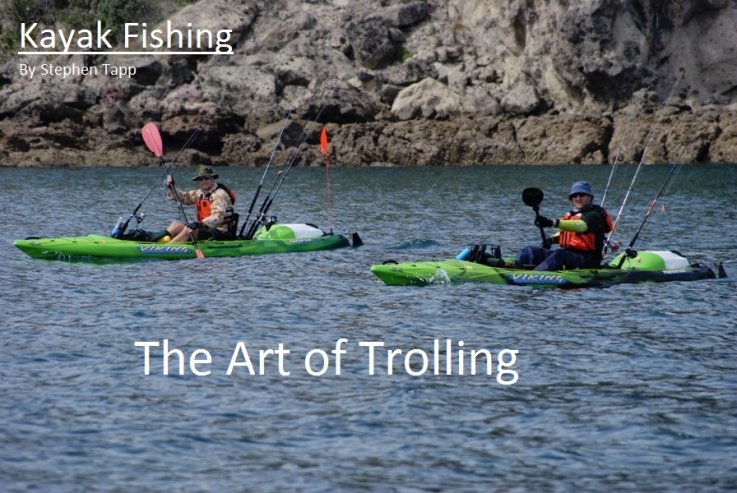
Trolling from kayaks in NZ, particularly over the warmer months, is rapidly developing into an art.
In the past it was simply a case of throwing small kahawai lures over the side whenever fresh bait was required, while other species were deemed either too difficult or utterly improbable to target from kayaks. Incidental captures were put down to flukes, and anyone trying to specifically target fish like tuna was simply suffering from too much sun!
I remember the surprised reactions of competitors several years ago at the inaugural Taranaki Kayak Classic (this year’s event takes place over March 10-11) when I rocked up with what was called the first west coast kayak-caught albacore tuna. The solid fish was outside the comp, but I needed a courtesy weigh for my home club. As I slid it from the ice and onto the scales, there were plenty of slaps on the back for the ‘lucky’ capture.
Since then I’ve landed tuna in every Taranaki Kayak Classic, and targeting them from kayaks in other parts of the country has become popular sport as well. During the 2011 summer, Bay of Plenty kayakers reportedly spotted skipjack in the waves off one of their favorite beaches, leading to some catching their first tuna not far offshore.
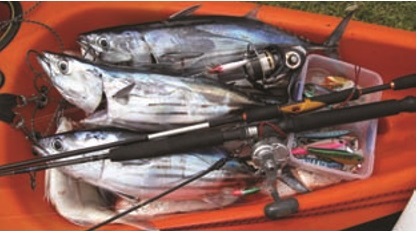
Skippies can be frustrating on kayaks where a faster trolling speed is sometimes required to get their attention. I’ve found the answer to effective trolling is to use lures that impart good action at the speeds we comfortably paddle at, such as these bibbed hard-bodies. These fish were landed recently when even much faster boaties were struggling to get a strike.
Another closely-related fish from the Scombridae family delivering awesome light-tackle fun is the blue or slimy mackerel. On trolled lures these pocket versions of the larger tunas are brilliantly easy to target, and larger specimens will stretch your angling skills on 1 and 2kg tackle. They’re also highly prized baits for larger fish, so very worthwhile targeting.
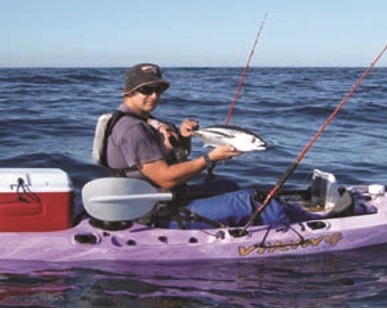
Pelagic speedsters like tunas and mackerels are prime trolling fodder, providing great sport on light gear and making excellent table fare at the end of the day.
Kingfish, particularly smaller ‘rats’ up to just over a meter in length, are willing candidates for trolled lures, especially on feathers and bibbed minnows. I’ve also successfully targeted big trevally under frenetic deep-diving bird activity (as opposed to notoriously fussy, surface-feeding trevally). These fish are torrid battlers, and large ones are often mistaken for kingfish, but their soft mouths see many being dropped before they’ve been identified.
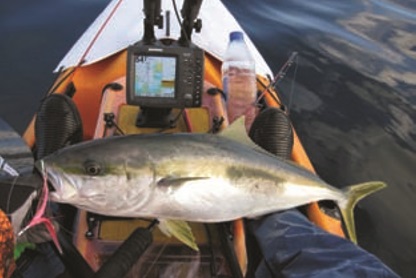
Rat kings offer brilliant catch-and-release sport; they willingly eat lures and stretch your angling skills on light tackle.
One species I’ve developed a passion for targeting with trolled lures is snapper. Over the last 10 years I’ve landed several when trolling, but never took this seriously as a technique for targeting them. Historically no New Zealander in their right mind would consider trolling for snapper – its bait, soft-baits, or jigs nothing else will do! However, now that I’m spending more time working with hard-body lures, I’m finding it’s possible to regularly catch snapper when trolling some of the new generation deep divers.
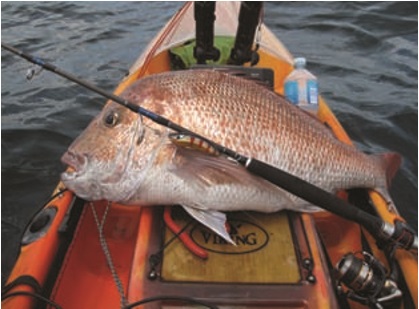
Snapper on deep divers; who would have thought trolling for snapper was viable? I now have several captures, including this 8.6kg fish (which had me thinking kingfish for the first couple of runs!).
Kayaks – stealth not speed
Trolling lures from kayaks means you’re going to have a busy day with the paddle. Having the right equipment is certainly going to make a difference a lightweight paddle, gloves for blister protection, the right clothing so you don’t overheat, and plenty of fluids to replace the sweat you’ll lose. One thing I have learned over the last couple of years is that trolling isn’t necessarily all about speed.
Yes, for some pelagic species speed is critical. Large kingfish are a classic example (as opposed to smaller ‘rats’ to just over a meter – these fish are easy trolling candidates). Hoodlums like larger lures (creating lots of drag), and you’ll need to paddle your arms off to get them to do more than just follow the lure. I now only target these big fish by trolling if I have following sea conditions to bump up my speed.
For most other species, I’ve found lure selection easily compensates for our more modest trolling speeds. The humble skipjack tuna is a prime example. Many of us have targeted these guys on saltwater flies and feathered trolling lures such as the Williamson lures and Tokoroa Chickens (a freshwater lure that serves sterling duty amongst knowing saltwater anglers). All have experienced the frustration of seeing skippies porpoising around us, and the boaties hauling them on board while we never get a touch.
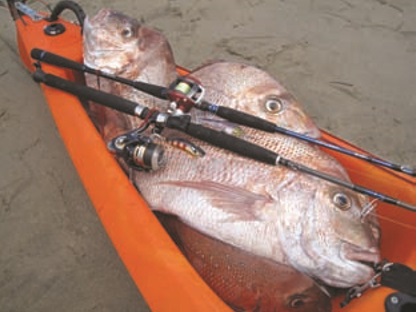
Like soft-baiting, trolling from a kayak for wary fish like snapper makes a lot of sense. The stealth of kayaks means fish aren’t ‘put on edge’, so they stay high in the water, allowing multiple passes until you find the lure combination that works.
Since adding hard-body lures to my arsenal, I’ve been able to reverse this. I still troll feathers with good success, but when the fishing gets tough, I now default back to small bibbed lures rather than try to paddle faster. The sound and vibration these lures put out, even at relatively slow speeds, makes them deadly, and I now regularly out-fish my boating mates on the hard days.
Another factor working to our advantage when targeting wary fish such as snapper and trevally is the kayak’s stealth. This allows us to work much closer to baitfish schools and repeatedly pass over our targets without ‘putting them down’. During summer I also encounter many snapper as mid-water fish when cruising between spots. A quiet kayak allows me multiple passes, each time varying lures and trolling speed if necessary to fool them into striking. This ability to keep trying until I find the winning formula has resulted in some fantastic fish captured, with my biggest trolled snapper going over 8.6kg (19lb)!
Work as a team
For some species the kayak’s stealth can actually work against us. Skipjack and albacore tuna are classic examples. Trolling tuna lures from boats tends to be particularly effective due to the sounds and wash created by the motor and hull mimicking thrashing and feeding fish, enticing the tuna to come in and investigate. Kayaks don’t generate this kind of commotion, so we need to look at other options for ringing the dinner bell.
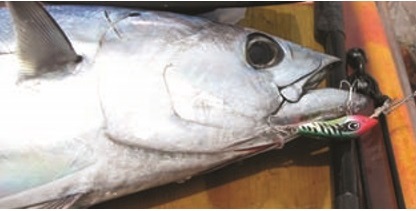
This little Aussie import shows how critical sharp hooks are. This skippy missed the lure, but the lure didn’t miss it, hooking up outside the jaw. Using top quality hardware is one of the secrets to success, regardless of the species being targeted
A simple solution is to troll more than one lure. This risks a multiple strike, always an adventure when fishing from kayaks, but is an effective way of creating more activity in the water. If doing this, I’ll only ever have two lures actually rigged with hooks, as I shudder to think of the carnage three or four hooked fish could create. If the ‘teaser’ lures are being hit, it’s a simple process to swap the hooks to them, and you gain the advantage of knowing exactly what the fish are interested in.
An advance on this is to add small tube flies or rubber skirts to the lines above your hooked lures. Again, the idea is to mimic a baitfish school, but care is needed not to add too much drag to the line. If running small bibbed lures or flies with light gauge hooks, the extra water pressure can be enough to pull the hooks from your prize.
Another point worth remembering is that we do actually create a little turbulence. Most of it comes from vortices generated by the tips of our paddle blades. This is often quite long lived (several minutes in calm conditions) and will show on sensitive sounders when passing through another paddler’s wake. For this reason I like to keep my lures within the width of my paddle strokes rather than spreading them as wide as possible from the kayak.
To get lure separation and avoid tangles, I run my lures staggered astern (rather than spreading them). I also make sure those running in the ‘shotgun’ position out the back float, and that any sinking or deep-diving lures are run close astern. This allows me to make relatively tight turns when tracking schools without having lines cross up. And, when I hook up, I can stop without fear of having a lure sink into the path of a line with a fish attached.
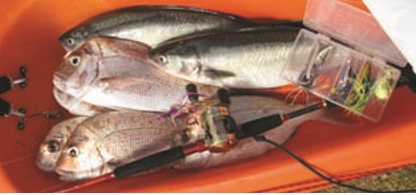
Trolled lures take many forms: skirted, feathered, hard-bodied and soft. Here, trolling with slow-jigs between snapper drifts added kahawai for the smoker.
This system has been very successful at minimizing macramé sessions offshore, provided you remember to clear each line, starting with the closest, until you get to the one with the fish on. I then play the fish aboard, unless it’s dived deep, allowing me to clear the farthest lines without risk of crossing up. This is an adventurous way of fishing (multiple lines in the water), but if you’re organized it can be done to great effect.
Another way to attract more fishy attention is to work together with your paddling mates. By paddling side-by-side we can greatly improve our chances at finding fish, attracting their attention, and getting them to eat our lures. This works regardless of whether you’re targeting snapper on deep divers, or tuna much closer to the surface. More lures in the water in close proximity look like a school of fish, and the combined wakes and paddle splashes give the impression of feeding activity.
Written by Stephen Tapp for the January 2013 NZ Fishing News mag
Stephen Tapp at Viking Kayaks can be contacted on 0800 529 253 if you have any kayak fishing related questions.





